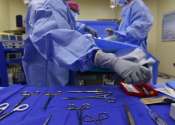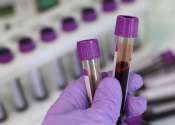Last update:
Biomedical technology news
Autism spectrum disorders
Scientists grow mini brains to uncover cells behind autism-related brain overgrowth
A new study in the lab of Jason Stein, Ph.D., modeled brain development in a dish to identify cells and genes that influence infant brain growth, a trait associated with autism.
23 hours ago
0
35
Gastroenterology
Intractable intestinal disease treatment: Xenogeneic-free polymer platform shows promise
Intestinal stem cells (ISCs) derived from a patient's own cells have garnered significant attention as a new alternative for treating intractable intestinal diseases due to their low risk of rejection. However, clinical application ...
22 hours ago
0
0
System replicates womb lining to 'listen in' to embryo-mother interactions during implantation
By engineering a system replicating the womb lining with high biological accuracy, researchers at the Babraham Institute and Stanford University have been able to study the implantation of human embryos, opening up this enigmatic ...
Dec 23, 2025
0
1

'Listening in' on the brain's hidden language: Engineered protein detects the faintest incoming signals
Scientists have engineered a protein able to record the incoming chemical signals of brain cells (as opposed to just their outgoing signals). These whisper-quiet incoming messages are the release of the neurotransmitter glutamate, ...
Dec 23, 2025
0
40

Testing AI logic in biomedical research
Manchester researchers have developed a systematic methodology to test whether AI can think logically in biomedical research, helping to ensure safer, more reliable applications in health care innovation.
Dec 23, 2025
0
0

One-button foodborne illness testing: Researchers develop fully automated integrated diagnostic system
Korea's first fully automated diagnostic system capable of simultaneously detecting 16 major foodborne pathogens within one hour has been successfully developed. Compared to conventional testing methods, the detection time ...
Dec 23, 2025
0
0

AI-powered wearable boosts preventative care for elderly
University of Arizona researchers in the Gutruf Lab have developed a comfortable, easy-to-use wearable device that incorporates artificial intelligence to detect subtle warning signs of frailty, signifying a leap forward ...
Dec 22, 2025
0
0

A new strategy for immune tolerance: Engineered extracellular vesicles show promise
A research team at the Nano Life Science Institute (WPI-NanoLSI) and the Faculty of Medicine at Kanazawa University has developed a new class of engineered extracellular vesicles (EVs) capable of inducing antigen-specific ...
Dec 22, 2025
0
0

New test could help enhance decision-making in treatment of chronic kidney disease in type 2 diabetics
Proteomics International Laboratories Ltd (ASX: PIQ) has announced the publication of a peer-reviewed Australian clinical utility study demonstrating that the PromarkerD blood test provides actionable information that significantly ...
Dec 22, 2025
0
0

New cases of syphilis in Alberta drop after introduction of rapid testing with immediate treatment
University of Alberta-led research reports that new cases of syphilis dropped in Alberta following the introduction of rapid point-of-care testing and same-day treatment. The research team compared new syphilis positivity ...
Dec 22, 2025
0
0

Study finds more comfortable option for guiding breast cancer surgery
A new study led by researchers at Wake Forest University School of Medicine and Atrium Health Levine Cancer has found that a modern technique for locating breast tumors before surgery, called radioactive seed localization ...
Dec 19, 2025
0
0

Special breathing tubes don't improve emergency intubation outcomes, trial finds
Modified endotracheal tubes designed to reduce patient pneumonia risk failed to improve outcomes compared to standard breathing tubes, researchers report in a new study.
Dec 18, 2025
0
0

Insights into dry eyes gained from stem-cell-derived tear glands
An estimated 5–15% of people have problems with dry eyes, with symptoms including eye redness, stinging, or burning sensation, and eye fatigue.
Dec 18, 2025
0
0

Model helps predict hip fractures among women with osteoporosis by analyzing only 7% of the joint
Scientists at Pompeu Fabra University (UPF) have made a great leap forward in predicting the risk of hip fracture among women due to osteoporosis. They have discovered that it is not necessary to examine all parts of the ...
Dec 18, 2025
0
0

Researchers identify 166 human pluripotent stem cell lines available for use in clinical applications
To date, more than 100 clinical trials with human pluripotent stem cell (hPSC)-derived products have been initiated worldwide and an increasing number of potential hPSC-derived clinical products have entered early developmental ...
Dec 18, 2025
0
0

Observing synapses in action: Images capture real-time neurotransmitter release
It takes just a few milliseconds: A vesicle, only a few nanometers in size and filled with neurotransmitters, approaches a cell membrane, fuses with it, and releases its chemical messengers into the synaptic cleft—making ...
Dec 17, 2025
0
125

'Zap-and-freeze' snapshots catch brain cells in the act of learning
Researchers at Leipzig University's Carl Ludwig Institute for Physiology, working in collaboration with Johns Hopkins University, have achieved an important breakthrough in brain research. The so-called zap-and-freeze technique, ...
Dec 17, 2025
0
25

Patient-specific human liver model lays foundation for personalized treatments
Liver disease is a major global health problem, causing over two million deaths worldwide each year. While animal models have helped to understand liver biology, they often fail to accurately translate to human biology.
Dec 17, 2025
0
32

3D bioprinting offers alternative to animal testing for skin disease research
At TU Wien, researchers are developing three-dimensional (3D) printing techniques that can be used to create living biological tissue—for example, to study skin diseases.
Dec 17, 2025
0
0

Some ventilator settings can double airway stress
Mechanical ventilation saves lives, but the airflow it produces inside an intubated airway can also shape conditions linked to complications during long-term support. In a recent study, SUNY Polytechnic Institute faculty ...
Dec 17, 2025
0
0

Ultrasound paired with vibrating nanoparticles softens tumor tissue, improving drug delivery
Cancer is one of the leading causes of death in the U.S., second only to heart disease. But a new cancer treatment method from CU Boulder researchers uses sound waves to soften tumors and could be a potent tool against the ...
Dec 16, 2025
0
23

New ALS diagnostic blood test boasts 97% accuracy
ALS is a debilitating paralytic disease characterized as the death of upper and lower motor neurons. Fortunately, ALS is relatively rare, with an incidence rate of 1.6 per 100,000 adults, resulting in about 30,000 cases in ...
Dec 16, 2025
0
0

Blood analysis shows whether brain cancer treatment is working
The effectiveness of chemotherapy for brain cancer, done with a technique that opens the blood-brain barrier, can be monitored by blood draw, researchers at Northwestern Medicine and the University of Michigan have shown.
Dec 16, 2025
0
0

'Tubuloids' offer a realistic platform for modeling chronic kidney disease
Chronic kidney disease (CKD) is a progressive condition that begins with tissue damage and gradually leads to loss of kidney function. The condition, which affects about 10% of the global population, is difficult to study ...
Dec 16, 2025
0
0

Rapid test developed for diagnosing hepatitis C virus
A rapid, highly accurate test has been developed for diagnosing hepatitis C virus (HCV), according to a study published online Dec. 10 in the Journal of Infectious Diseases.
Dec 16, 2025
0
0













































